Academic Report: Employee Motivation, Theories, and Corporate Culture
VerifiedAdded on 2023/06/08
|7
|1608
|446
Report
AI Summary
This report delves into the crucial aspect of employee motivation within organizations, emphasizing its impact on productivity and goal achievement. It explores various motivation theories such as Maslow's hierarchy of needs and McGregor's Theory X and Y, providing insights into how managers can effectively leverage these concepts. Furthermore, the report highlights the significance of developing an optimal organizational culture to foster employee engagement, creativity, and commitment. Key strategies for cultivating such a culture include improving team dynamics, modernizing the workplace environment, promoting clear communication, encouraging teamwork, and fostering a reward-based system. The report concludes that a well-defined and supportive corporate culture is instrumental in sustaining high levels of employee motivation and driving overall organizational success.
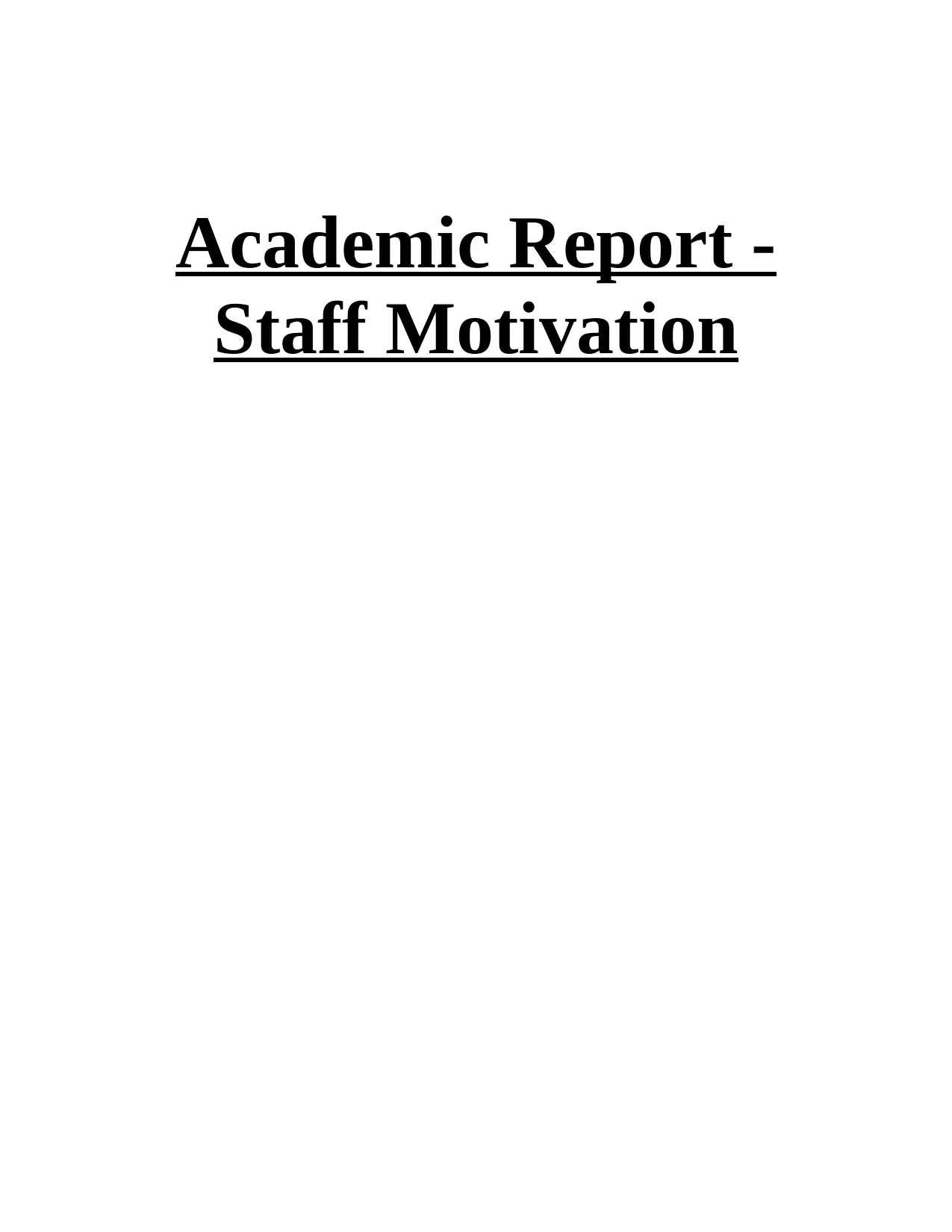
Academic Report -
Staff Motivation
Staff Motivation
Paraphrase This Document
Need a fresh take? Get an instant paraphrase of this document with our AI Paraphraser
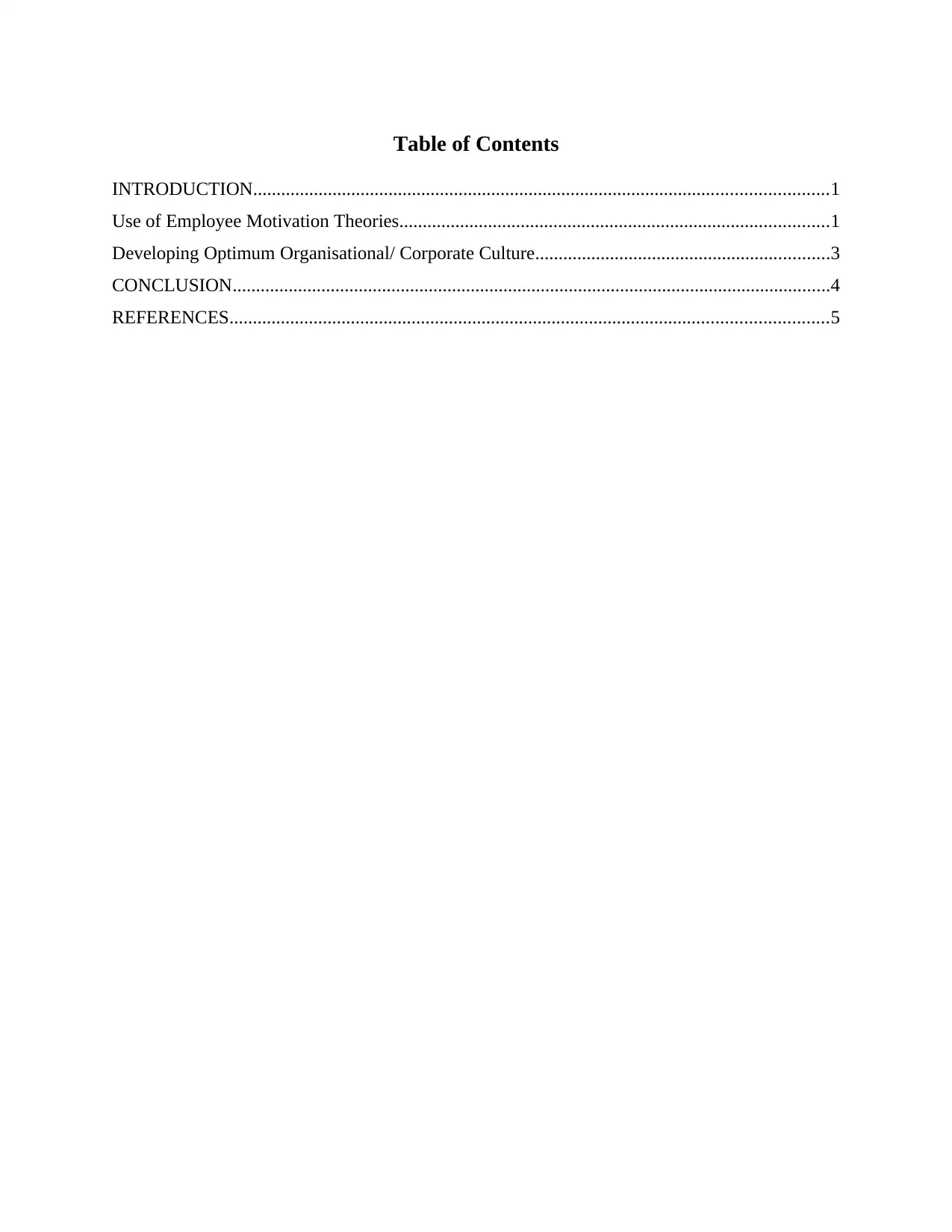
Table of Contents
INTRODUCTION...........................................................................................................................1
Use of Employee Motivation Theories............................................................................................1
Developing Optimum Organisational/ Corporate Culture...............................................................3
CONCLUSION................................................................................................................................4
REFERENCES................................................................................................................................5
INTRODUCTION...........................................................................................................................1
Use of Employee Motivation Theories............................................................................................1
Developing Optimum Organisational/ Corporate Culture...............................................................3
CONCLUSION................................................................................................................................4
REFERENCES................................................................................................................................5
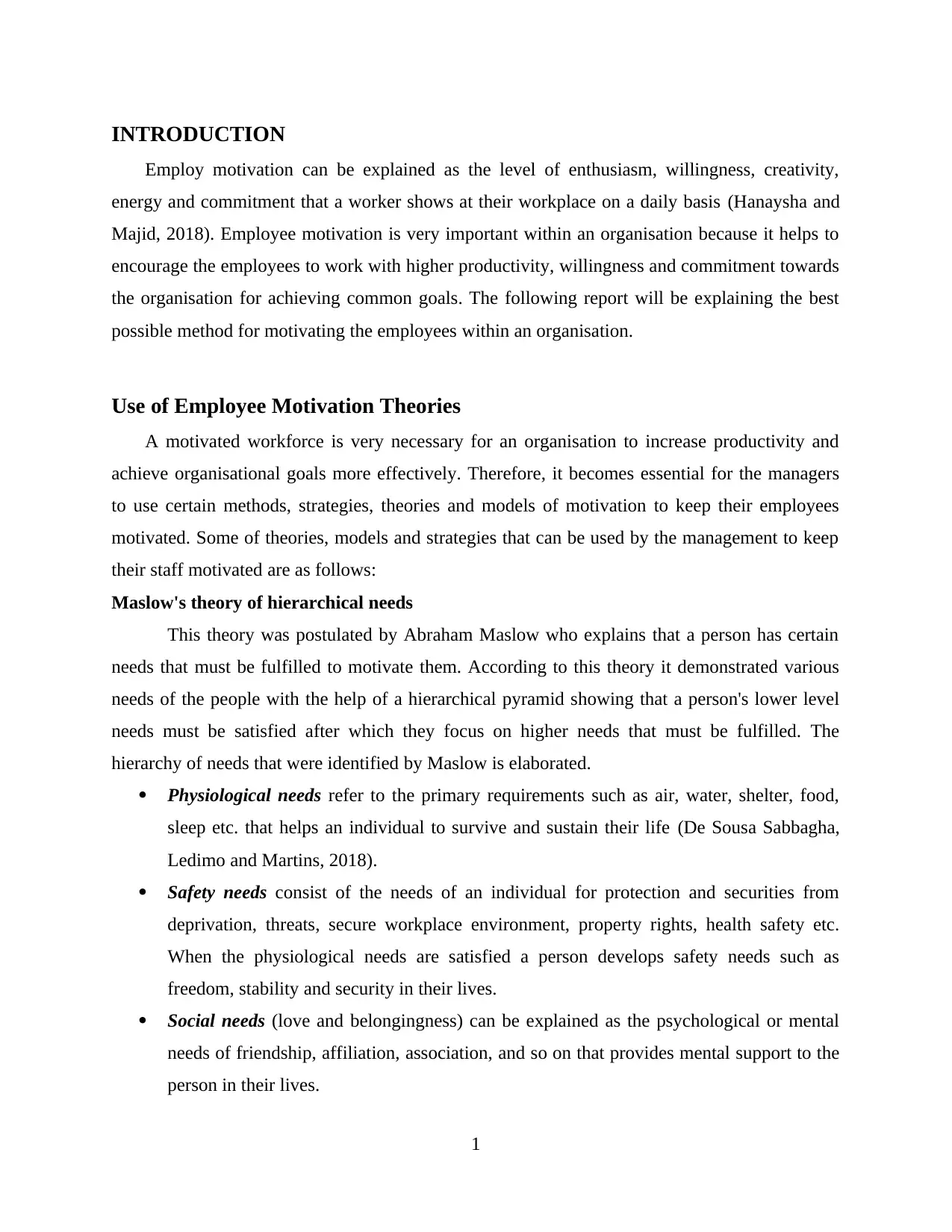
INTRODUCTION
Employ motivation can be explained as the level of enthusiasm, willingness, creativity,
energy and commitment that a worker shows at their workplace on a daily basis (Hanaysha and
Majid, 2018). Employee motivation is very important within an organisation because it helps to
encourage the employees to work with higher productivity, willingness and commitment towards
the organisation for achieving common goals. The following report will be explaining the best
possible method for motivating the employees within an organisation.
Use of Employee Motivation Theories
A motivated workforce is very necessary for an organisation to increase productivity and
achieve organisational goals more effectively. Therefore, it becomes essential for the managers
to use certain methods, strategies, theories and models of motivation to keep their employees
motivated. Some of theories, models and strategies that can be used by the management to keep
their staff motivated are as follows:
Maslow's theory of hierarchical needs
This theory was postulated by Abraham Maslow who explains that a person has certain
needs that must be fulfilled to motivate them. According to this theory it demonstrated various
needs of the people with the help of a hierarchical pyramid showing that a person's lower level
needs must be satisfied after which they focus on higher needs that must be fulfilled. The
hierarchy of needs that were identified by Maslow is elaborated.
Physiological needs refer to the primary requirements such as air, water, shelter, food,
sleep etc. that helps an individual to survive and sustain their life (De Sousa Sabbagha,
Ledimo and Martins, 2018).
Safety needs consist of the needs of an individual for protection and securities from
deprivation, threats, secure workplace environment, property rights, health safety etc.
When the physiological needs are satisfied a person develops safety needs such as
freedom, stability and security in their lives.
Social needs (love and belongingness) can be explained as the psychological or mental
needs of friendship, affiliation, association, and so on that provides mental support to the
person in their lives.
1
Employ motivation can be explained as the level of enthusiasm, willingness, creativity,
energy and commitment that a worker shows at their workplace on a daily basis (Hanaysha and
Majid, 2018). Employee motivation is very important within an organisation because it helps to
encourage the employees to work with higher productivity, willingness and commitment towards
the organisation for achieving common goals. The following report will be explaining the best
possible method for motivating the employees within an organisation.
Use of Employee Motivation Theories
A motivated workforce is very necessary for an organisation to increase productivity and
achieve organisational goals more effectively. Therefore, it becomes essential for the managers
to use certain methods, strategies, theories and models of motivation to keep their employees
motivated. Some of theories, models and strategies that can be used by the management to keep
their staff motivated are as follows:
Maslow's theory of hierarchical needs
This theory was postulated by Abraham Maslow who explains that a person has certain
needs that must be fulfilled to motivate them. According to this theory it demonstrated various
needs of the people with the help of a hierarchical pyramid showing that a person's lower level
needs must be satisfied after which they focus on higher needs that must be fulfilled. The
hierarchy of needs that were identified by Maslow is elaborated.
Physiological needs refer to the primary requirements such as air, water, shelter, food,
sleep etc. that helps an individual to survive and sustain their life (De Sousa Sabbagha,
Ledimo and Martins, 2018).
Safety needs consist of the needs of an individual for protection and securities from
deprivation, threats, secure workplace environment, property rights, health safety etc.
When the physiological needs are satisfied a person develops safety needs such as
freedom, stability and security in their lives.
Social needs (love and belongingness) can be explained as the psychological or mental
needs of friendship, affiliation, association, and so on that provides mental support to the
person in their lives.
1
⊘ This is a preview!⊘
Do you want full access?
Subscribe today to unlock all pages.

Trusted by 1+ million students worldwide
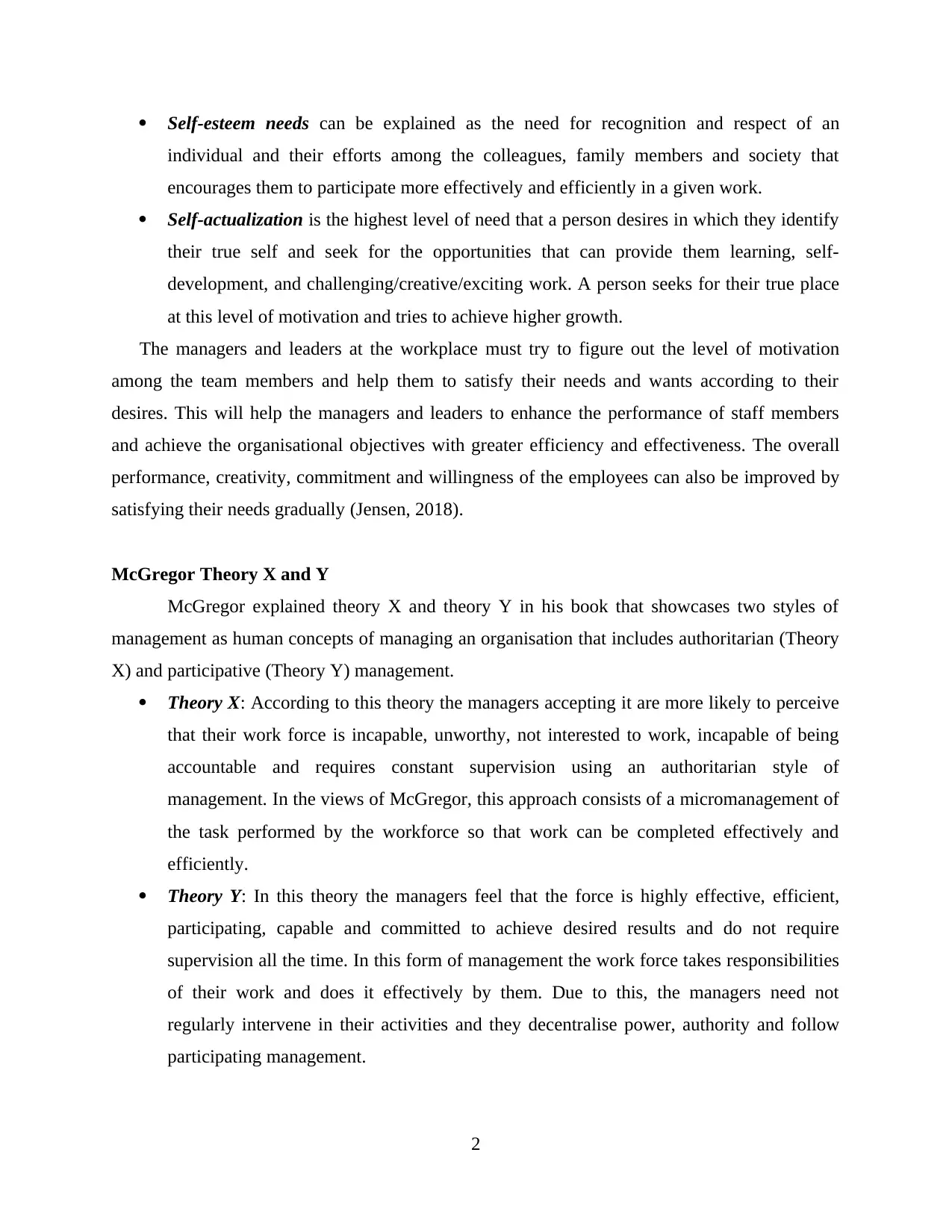
Self-esteem needs can be explained as the need for recognition and respect of an
individual and their efforts among the colleagues, family members and society that
encourages them to participate more effectively and efficiently in a given work.
Self-actualization is the highest level of need that a person desires in which they identify
their true self and seek for the opportunities that can provide them learning, self-
development, and challenging/creative/exciting work. A person seeks for their true place
at this level of motivation and tries to achieve higher growth.
The managers and leaders at the workplace must try to figure out the level of motivation
among the team members and help them to satisfy their needs and wants according to their
desires. This will help the managers and leaders to enhance the performance of staff members
and achieve the organisational objectives with greater efficiency and effectiveness. The overall
performance, creativity, commitment and willingness of the employees can also be improved by
satisfying their needs gradually (Jensen, 2018).
McGregor Theory X and Y
McGregor explained theory X and theory Y in his book that showcases two styles of
management as human concepts of managing an organisation that includes authoritarian (Theory
X) and participative (Theory Y) management.
Theory X: According to this theory the managers accepting it are more likely to perceive
that their work force is incapable, unworthy, not interested to work, incapable of being
accountable and requires constant supervision using an authoritarian style of
management. In the views of McGregor, this approach consists of a micromanagement of
the task performed by the workforce so that work can be completed effectively and
efficiently.
Theory Y: In this theory the managers feel that the force is highly effective, efficient,
participating, capable and committed to achieve desired results and do not require
supervision all the time. In this form of management the work force takes responsibilities
of their work and does it effectively by them. Due to this, the managers need not
regularly intervene in their activities and they decentralise power, authority and follow
participating management.
2
individual and their efforts among the colleagues, family members and society that
encourages them to participate more effectively and efficiently in a given work.
Self-actualization is the highest level of need that a person desires in which they identify
their true self and seek for the opportunities that can provide them learning, self-
development, and challenging/creative/exciting work. A person seeks for their true place
at this level of motivation and tries to achieve higher growth.
The managers and leaders at the workplace must try to figure out the level of motivation
among the team members and help them to satisfy their needs and wants according to their
desires. This will help the managers and leaders to enhance the performance of staff members
and achieve the organisational objectives with greater efficiency and effectiveness. The overall
performance, creativity, commitment and willingness of the employees can also be improved by
satisfying their needs gradually (Jensen, 2018).
McGregor Theory X and Y
McGregor explained theory X and theory Y in his book that showcases two styles of
management as human concepts of managing an organisation that includes authoritarian (Theory
X) and participative (Theory Y) management.
Theory X: According to this theory the managers accepting it are more likely to perceive
that their work force is incapable, unworthy, not interested to work, incapable of being
accountable and requires constant supervision using an authoritarian style of
management. In the views of McGregor, this approach consists of a micromanagement of
the task performed by the workforce so that work can be completed effectively and
efficiently.
Theory Y: In this theory the managers feel that the force is highly effective, efficient,
participating, capable and committed to achieve desired results and do not require
supervision all the time. In this form of management the work force takes responsibilities
of their work and does it effectively by them. Due to this, the managers need not
regularly intervene in their activities and they decentralise power, authority and follow
participating management.
2
Paraphrase This Document
Need a fresh take? Get an instant paraphrase of this document with our AI Paraphraser
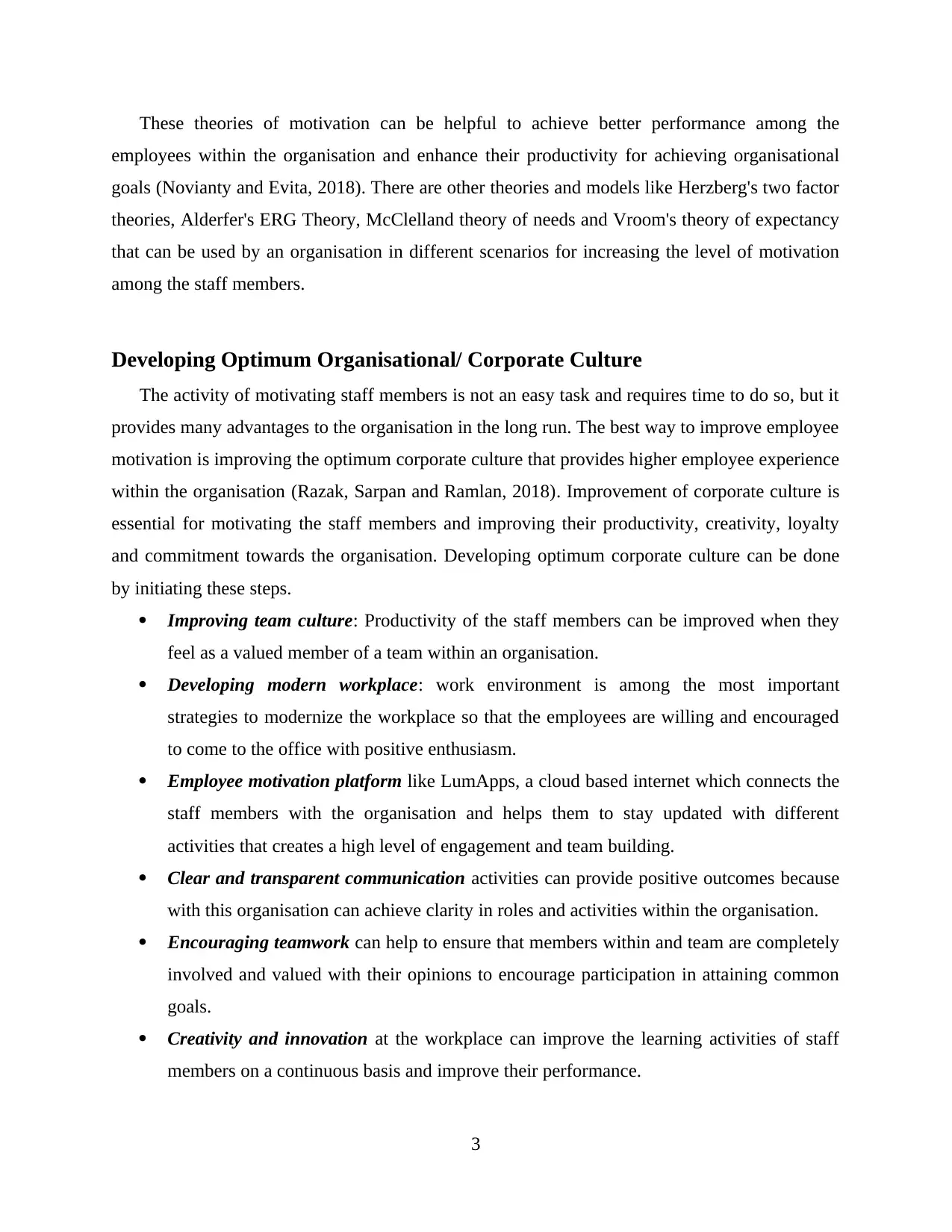
These theories of motivation can be helpful to achieve better performance among the
employees within the organisation and enhance their productivity for achieving organisational
goals (Novianty and Evita, 2018). There are other theories and models like Herzberg's two factor
theories, Alderfer's ERG Theory, McClelland theory of needs and Vroom's theory of expectancy
that can be used by an organisation in different scenarios for increasing the level of motivation
among the staff members.
Developing Optimum Organisational/ Corporate Culture
The activity of motivating staff members is not an easy task and requires time to do so, but it
provides many advantages to the organisation in the long run. The best way to improve employee
motivation is improving the optimum corporate culture that provides higher employee experience
within the organisation (Razak, Sarpan and Ramlan, 2018). Improvement of corporate culture is
essential for motivating the staff members and improving their productivity, creativity, loyalty
and commitment towards the organisation. Developing optimum corporate culture can be done
by initiating these steps.
Improving team culture: Productivity of the staff members can be improved when they
feel as a valued member of a team within an organisation.
Developing modern workplace: work environment is among the most important
strategies to modernize the workplace so that the employees are willing and encouraged
to come to the office with positive enthusiasm.
Employee motivation platform like LumApps, a cloud based internet which connects the
staff members with the organisation and helps them to stay updated with different
activities that creates a high level of engagement and team building.
Clear and transparent communication activities can provide positive outcomes because
with this organisation can achieve clarity in roles and activities within the organisation.
Encouraging teamwork can help to ensure that members within and team are completely
involved and valued with their opinions to encourage participation in attaining common
goals.
Creativity and innovation at the workplace can improve the learning activities of staff
members on a continuous basis and improve their performance.
3
employees within the organisation and enhance their productivity for achieving organisational
goals (Novianty and Evita, 2018). There are other theories and models like Herzberg's two factor
theories, Alderfer's ERG Theory, McClelland theory of needs and Vroom's theory of expectancy
that can be used by an organisation in different scenarios for increasing the level of motivation
among the staff members.
Developing Optimum Organisational/ Corporate Culture
The activity of motivating staff members is not an easy task and requires time to do so, but it
provides many advantages to the organisation in the long run. The best way to improve employee
motivation is improving the optimum corporate culture that provides higher employee experience
within the organisation (Razak, Sarpan and Ramlan, 2018). Improvement of corporate culture is
essential for motivating the staff members and improving their productivity, creativity, loyalty
and commitment towards the organisation. Developing optimum corporate culture can be done
by initiating these steps.
Improving team culture: Productivity of the staff members can be improved when they
feel as a valued member of a team within an organisation.
Developing modern workplace: work environment is among the most important
strategies to modernize the workplace so that the employees are willing and encouraged
to come to the office with positive enthusiasm.
Employee motivation platform like LumApps, a cloud based internet which connects the
staff members with the organisation and helps them to stay updated with different
activities that creates a high level of engagement and team building.
Clear and transparent communication activities can provide positive outcomes because
with this organisation can achieve clarity in roles and activities within the organisation.
Encouraging teamwork can help to ensure that members within and team are completely
involved and valued with their opinions to encourage participation in attaining common
goals.
Creativity and innovation at the workplace can improve the learning activities of staff
members on a continuous basis and improve their performance.
3
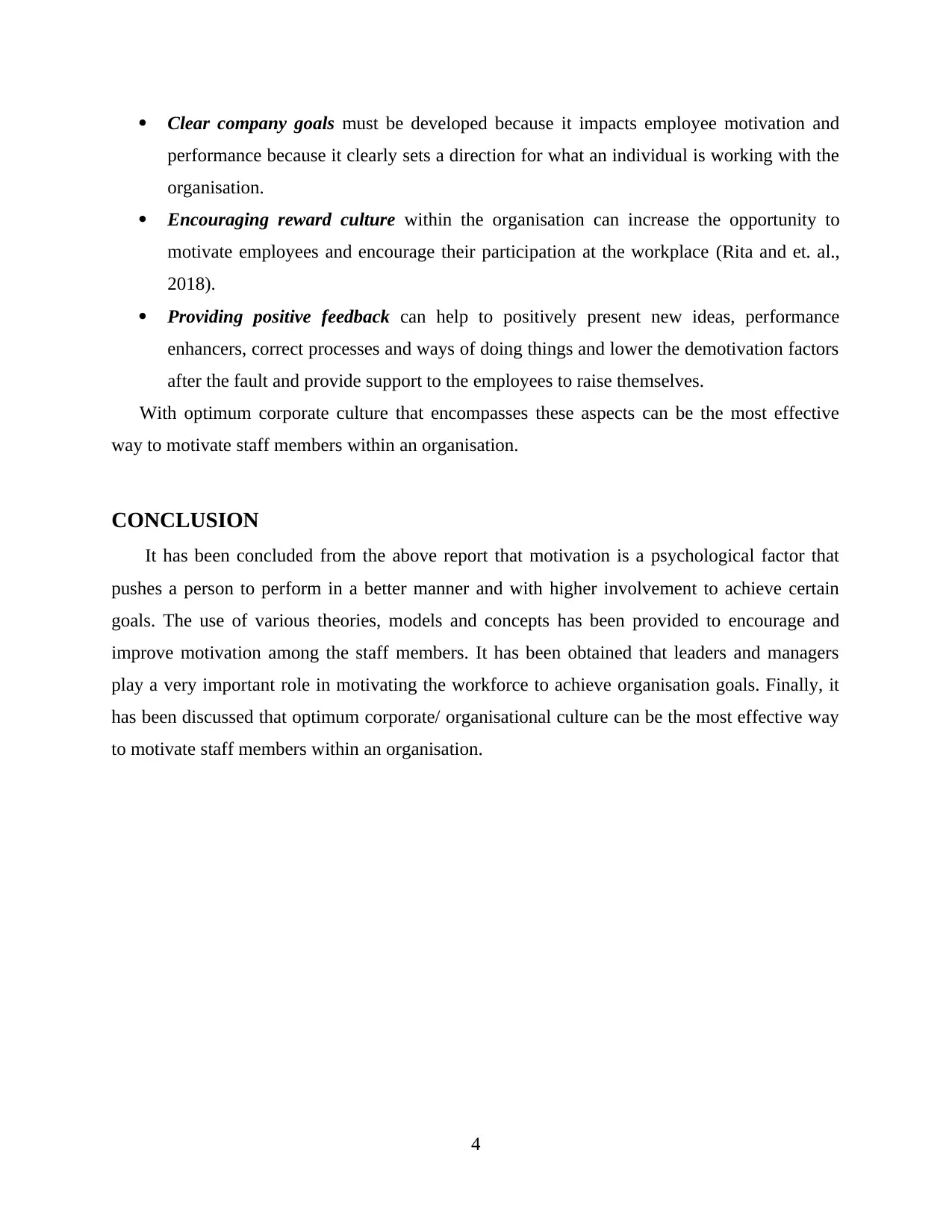
Clear company goals must be developed because it impacts employee motivation and
performance because it clearly sets a direction for what an individual is working with the
organisation.
Encouraging reward culture within the organisation can increase the opportunity to
motivate employees and encourage their participation at the workplace (Rita and et. al.,
2018).
Providing positive feedback can help to positively present new ideas, performance
enhancers, correct processes and ways of doing things and lower the demotivation factors
after the fault and provide support to the employees to raise themselves.
With optimum corporate culture that encompasses these aspects can be the most effective
way to motivate staff members within an organisation.
CONCLUSION
It has been concluded from the above report that motivation is a psychological factor that
pushes a person to perform in a better manner and with higher involvement to achieve certain
goals. The use of various theories, models and concepts has been provided to encourage and
improve motivation among the staff members. It has been obtained that leaders and managers
play a very important role in motivating the workforce to achieve organisation goals. Finally, it
has been discussed that optimum corporate/ organisational culture can be the most effective way
to motivate staff members within an organisation.
4
performance because it clearly sets a direction for what an individual is working with the
organisation.
Encouraging reward culture within the organisation can increase the opportunity to
motivate employees and encourage their participation at the workplace (Rita and et. al.,
2018).
Providing positive feedback can help to positively present new ideas, performance
enhancers, correct processes and ways of doing things and lower the demotivation factors
after the fault and provide support to the employees to raise themselves.
With optimum corporate culture that encompasses these aspects can be the most effective
way to motivate staff members within an organisation.
CONCLUSION
It has been concluded from the above report that motivation is a psychological factor that
pushes a person to perform in a better manner and with higher involvement to achieve certain
goals. The use of various theories, models and concepts has been provided to encourage and
improve motivation among the staff members. It has been obtained that leaders and managers
play a very important role in motivating the workforce to achieve organisation goals. Finally, it
has been discussed that optimum corporate/ organisational culture can be the most effective way
to motivate staff members within an organisation.
4
⊘ This is a preview!⊘
Do you want full access?
Subscribe today to unlock all pages.

Trusted by 1+ million students worldwide
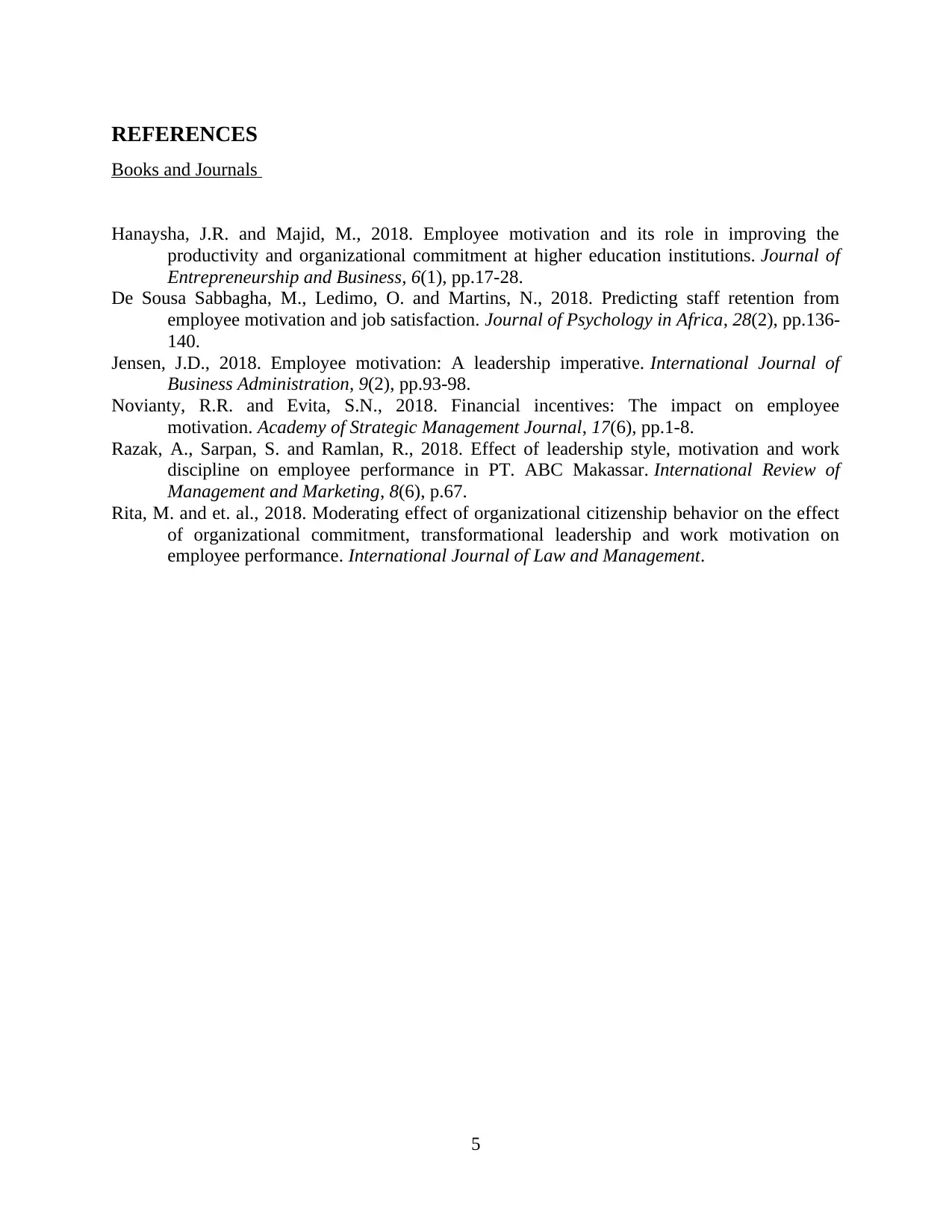
REFERENCES
Books and Journals
Hanaysha, J.R. and Majid, M., 2018. Employee motivation and its role in improving the
productivity and organizational commitment at higher education institutions. Journal of
Entrepreneurship and Business, 6(1), pp.17-28.
De Sousa Sabbagha, M., Ledimo, O. and Martins, N., 2018. Predicting staff retention from
employee motivation and job satisfaction. Journal of Psychology in Africa, 28(2), pp.136-
140.
Jensen, J.D., 2018. Employee motivation: A leadership imperative. International Journal of
Business Administration, 9(2), pp.93-98.
Novianty, R.R. and Evita, S.N., 2018. Financial incentives: The impact on employee
motivation. Academy of Strategic Management Journal, 17(6), pp.1-8.
Razak, A., Sarpan, S. and Ramlan, R., 2018. Effect of leadership style, motivation and work
discipline on employee performance in PT. ABC Makassar. International Review of
Management and Marketing, 8(6), p.67.
Rita, M. and et. al., 2018. Moderating effect of organizational citizenship behavior on the effect
of organizational commitment, transformational leadership and work motivation on
employee performance. International Journal of Law and Management.
5
Books and Journals
Hanaysha, J.R. and Majid, M., 2018. Employee motivation and its role in improving the
productivity and organizational commitment at higher education institutions. Journal of
Entrepreneurship and Business, 6(1), pp.17-28.
De Sousa Sabbagha, M., Ledimo, O. and Martins, N., 2018. Predicting staff retention from
employee motivation and job satisfaction. Journal of Psychology in Africa, 28(2), pp.136-
140.
Jensen, J.D., 2018. Employee motivation: A leadership imperative. International Journal of
Business Administration, 9(2), pp.93-98.
Novianty, R.R. and Evita, S.N., 2018. Financial incentives: The impact on employee
motivation. Academy of Strategic Management Journal, 17(6), pp.1-8.
Razak, A., Sarpan, S. and Ramlan, R., 2018. Effect of leadership style, motivation and work
discipline on employee performance in PT. ABC Makassar. International Review of
Management and Marketing, 8(6), p.67.
Rita, M. and et. al., 2018. Moderating effect of organizational citizenship behavior on the effect
of organizational commitment, transformational leadership and work motivation on
employee performance. International Journal of Law and Management.
5
1 out of 7